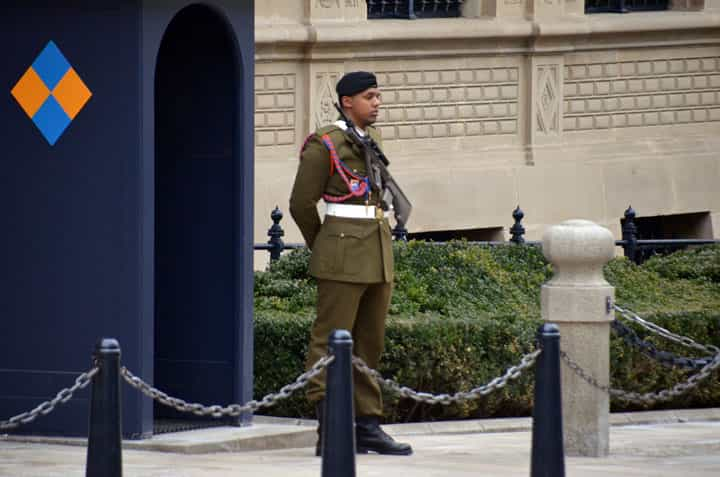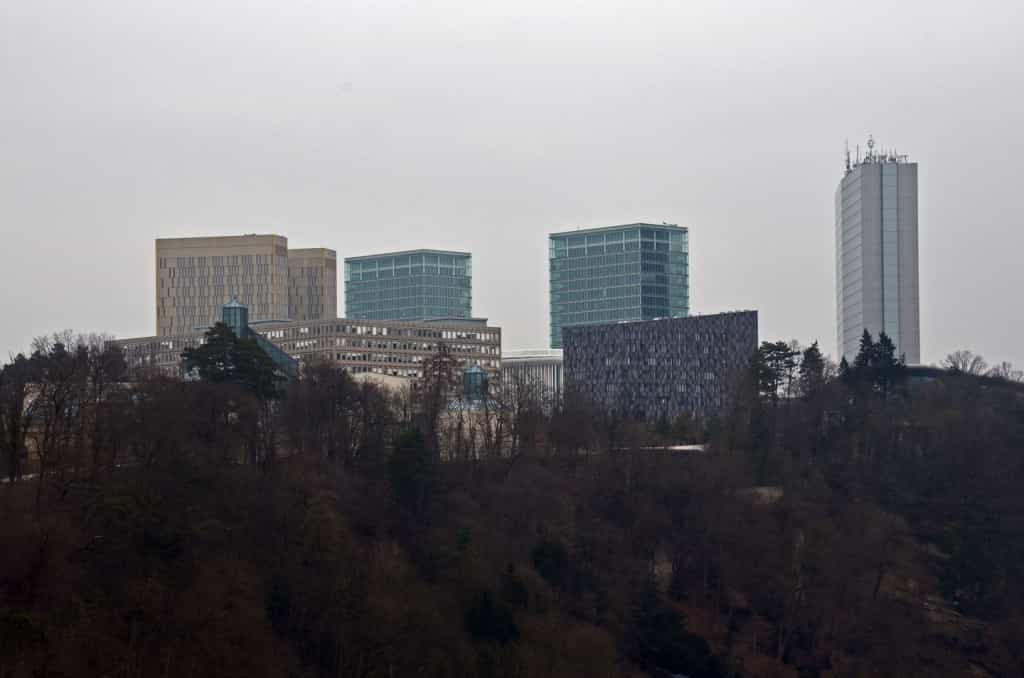I had planned to travel to Luxembourg last year, but logistical difficulties made me cancel the visit. I again had problems with transportation and schedule, but I wasn’t going to cancel my trip once more, so I went, even though the stay would be way too short. As is often the case with air travel, earlier flights were 3-4 times more expensive, and I couldn’t stay over the week-end, as I wanted to visit friends in Belgium. So here’s my ~30 hour visit to Luxembourg.
I didn’t start by visiting the Grand-Ducal Palace, I stumbled upon it by chance. It differs from typical European palaces in two ways. First, it doesn’t sit on a massive piece of land, it is right downtown, on the street. Second, it physically shares a wall with Parliament. Luckily for the Grand Duke (the only reigning Grand Duke in the world), the Palace is where he works, not where he lives.
A long time ago, the street in front of the Parliament housed a herb market. This history has remained even though the market is long gone. In Canada and the United States, journalists will often refer to a law being discussed “on the hill” (Parliament and Capitol Hill, respectively). In Luxembourg, they say “… and the new bill was proposed today at the herb market”!
You might notice that the Luxembourgish flag looks a lot like the Dutch flag. In fact, it is exactly the same, except the blue stripe is a different tone. Not surprising then to learn that the King of the Netherlands reigned over Liechtenstein until 1890.
In Luxembourg as in most places, ceremonial guards look to their front and remain immobile. They look sharp and give and important and solemn air to the place they guard.
Of course, the level of security they provide is, well, ceremonial. And people make graffiti on the wall of the Palace. I was a little surprised they would leave it there.
But less then an hour later, I saw they had no such intention!
I started visiting Luxembourg-Ville by walking around the old fortifications. Unlike so many decrepit defensive works around the world, they did not get to this state of disrepair through centuries of neglect, or even foreign invasions. The Second Treaty of London, in 1867, declared Luxembourg to be a neutral state, and this called for the dismantlement of the fortifications. For the next 15 years, the people of Luxembourg destroyed most of the massive towers and walls surrounding the city. Incidentally, in 1871, modern Germany was born and over the next 50 years, they invaded the neutral country twice.
One thing they could not destroy was the 23 km of underground tunnels. They are so pervasive that blowing them up would threaten the stability of many buildings. 17 km are still in existence and parts of it can be visited, such as the Casemate Bock, shown in these two pictures.
Following the exploration of the fortress, I went on a guided walking tour of the city. Since it was freezing cold outside, we asked a lot of questions every time we got indoors. On this stained glass window, one panel reads “1687 – Louis XIV fait don de 4,000 Thalers”. Being a devout Catholic, the Sun King paid this handsome sum to rebuild the 10th Century church his own invading armies had just destroyed!
A simple message in a country with a complex history: “We want to remain what we are”. While Luxembourgish is the national language, French is the official language.
Although the city was beautiful despite the harsh weather, I couldn’t help but wonder how nice the parks must look in the summer.
The Adolph Bridge, with the longest arch span for a stone bridge when it was constructed, in 1900. But they cheated a little, introducing a revolutionary material at the time, reinforced concrete. Major upgrade work is to be conducted in the next few years, enough to warrant the construction of a temporary bridge.
I don’t remember that much about the tour, since at 2 degrees without a hat, my brain was frozen. This is the judicial district, as exciting as you would expect.
While this building is a financial institution of sorts, earlier in the day my tour guide was describing Government buildings, including the office of the Prime Minister. As she was talking, two men walked behind her. I paid no attention to them, but one of the German tourist interrupted the guide and saluted the passing men, who saluted back and kept going. It was the Prime Minister, walking to the local pizzeria for lunch. A rather laid-back country indeed.
Luxembourg was founded in 963. The small bridge in the centre of the picture is nearly 1,000 years older than the train going by!
Luxembourg is a very rich country, probably one of about three with a GDP per capita above US$100,000 (with Liechtenstein and Monaco). Annual GDP per capita in Ethiopia, where I spent most of December, is about equal to Luxembourg GDP per capita, per day! Talk about a contrast. These incredible numbers are in part due to the huge economic output of people working, but not living, in Luxembourg. Due to high housing costs (and good public transportation), 44% of salaried workers in the country do not live there, but transit daily from France (~80,000), Belgium and Germany (~40,000 each). Only 29% of employees are Luxembourgish citizens.
On top of this hill, nearly 10,000 EU and UN workers push papers all day long. The main activity is translating EU stuff into its 23 official languages!
#Luxembourg
















like the laid back attitude great piece enjoyed it keep it coming